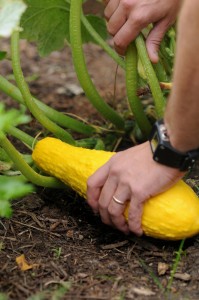Squash for All Seasons
Posted in Exhibitions, The Edible Garden on July 14 2010, by Plant Talk
| Written by Burpee Home Gardens Team. Burpee is a Supporting Sponsor of The Edible Garden. |
 The interesting thing about home vegetable gardens (and one that experienced gardeners learn to perfect), is that they evolve with the seasons. From cool to warm to hot, and back again, each of these cycles provides an opportunity to plant different crops for a maximized garden harvest.
The interesting thing about home vegetable gardens (and one that experienced gardeners learn to perfect), is that they evolve with the seasons. From cool to warm to hot, and back again, each of these cycles provides an opportunity to plant different crops for a maximized garden harvest.
One of the best-loved varieties that supply multi-seasonal recipes at your table is the trusty squash. We love the fact that you can grow a squash for almost every holiday recipe, from the Fourth of July cookout to Christmas dinner. Whether in the salad bowl or on the grill, in soup or in bread, squash can do it all. You can even eat squash blossoms—cooked or raw! Blossoms are a special treat reserved for only the best restaurants (and home gardeners) because of their perishable and delicate nature. But best of all, squash is one of the easiest and most prolific vegetables you can plant in your garden, and with success.
Native to the Americas, squash can be divided into two types: summer and winter. Summer squashes ripen quickly (as fast as 50 days). Winter squashes and their hard rinds ripen later. Summer squashes such as yellow, crookneck, and zucchini are eaten soon after harvesting—skin and all. They’re great eaten raw (with vegetable trays), steamed, grilled, or boiled. You can stuff them and bake them or grate larger-sized ones for delicious and flavorful breads. Winter squashes such as acorn and butternut, are often cut in half and baked, or boiled and then mashed like potatoes.
While squash is easy to maintain in a garden, many first-time gardeners underestimate just how much space is needed to grow these vine-type plants. Summer squashes are bushy, semi-vining plants that need three square feet for each plant. Allow for even more space for winter squash.
As for harvesting, summer squashes grow quickly, in just a little less than two months. A squash that’s too small one day will be a foot long two days later, so check your plants daily. For the most tender and best flavor, harvest summer squashes when they’re 1 to 2 inches in diameter and 6 to 8 inches long. Your plants will continue to set fruit as long as the plants are healthy and growing. Winter squashes are ready much later (about 80 days from planting). Watch for a deep color and a tough, hard skin before cutting from the vine.
Similar to a pumpkin, store your winter squashes in a basement or unheated space at 45–50°F. If you prefer to freeze your squash, blanch the summer types and cook the winter ones. You can, of course, eat them right away, too, and there’s plenty of satisfaction in that. But preserving and storing your harvest fully extends the enjoyment of the fruits of your garden labor.


My husband and I are big squash fans and have come up with lots of ways to make use of the different varieties we grow. Maybe the only thing we haven’t tried yet is putting shreaded zucchini on our morning cereal.
We are finding ourselves in a situation this year of having a bumper crop of summer squash. Because of the squash borer we get hit with every year we plant twice… once at end of May and again in a different area about the 1st of July.
Funny thing happened this year in our garden…NO squash borers…. so many squash that family and friends won’t make eye contact for fear you will ask if they want more lol.